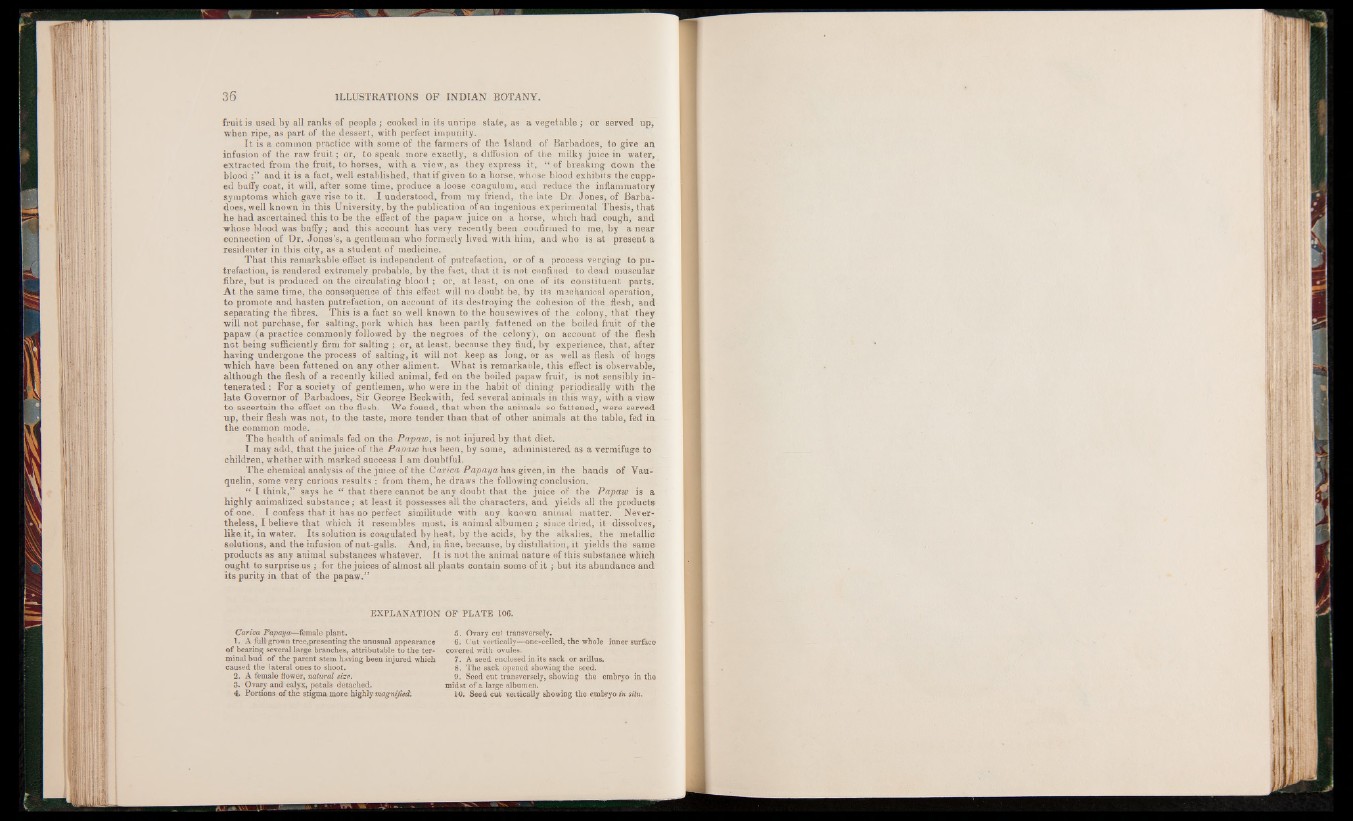
fruit is used by all ranks of people ; cooked in its unripe state, as a vegetable ; or served up,
when ripe, as part of the dessert, with perfect impunity.
It is a common practice with some of the farmers of the Island of Barbadoes, to give an
infusion of the raw fruit; or, to speak more exactly, a diffusion of the milky juice in water,
extracted from the fruit, to horses, with a view, as they express it, “ of breaking down the
blood and it is a fact, well established, that if given to a horse, whose blood exhibits the cupped
buffy coat, it will, after some time, produce a loose coagulum, and reduce the inflammatory
symptoms which gave rise to it. J understood, from my friend, the late Dr. Jones; of Barbadoes,
well known in this University, by the publication of an ingenious experimental Thesis, that
he had ascertained this to be the effect of the papaw juice on a horse, which had cough, and
whose blood was buffy; and this account has very recently been confirmed to me, by a near
connection of Dr. Jones’s, a gentleman who formerly lived with him, and who is at present a
residenter in this city, as a student of medicine.
That this remarkable effect is independent of putrefaction, or of a process verging to putrefaction,
is rendered extremely probable, by the fact, that it is not confined to dead muscular
fibre, but is produced on the circulating blood ; or, at least, on one of its constituent parts.
At the same time, the consequence of this effect will no doubt be, by its mechanical operation,
to promote and hasten putrefaction, on account of its destroying the cohesion of the ftesh, and
separating the fibres. This is a fact so well known to the housewives of the colony, that' they
will not purchase, for salting, pork which has been partly fattened on the boiled fruit of the
papaw (a practice commonly followed by the negroes of the colony), on account of the flesh
not being sufficiently firm for salting ; or, at least, because they find, by experience, that, after
having undergone the process of salting, it will not keep as long, or as well as flesh of hogs
which have been fattened on any other aliment. What is remarkable, this effect is observable,
although the flesh of a recently killed animal, fed on the boiled papaw fruit, is not sensibly in-
tenerated : For a society of gentlemen, who were in the habit of dining periodically with the
late Governor of Barbadoes, Sir George Beckwith, fed several animals in this way, with a view
to ascertain the effect on the flesh. We found, that when the animals so fattened, were served
up, their flesh was not, to the taste, more tender than that of other animals at the table, fed in
the common mode.
The health of animals fed on the Papaw, is not injured by that diet.
I may add, that the juice of the Papaw has been, by some, administered as a vermifuge to
children, whether with marked success I am doubtful.
The chemical analysis of the juice of the Carica Papaya has given, in the hands of Vau-
quelin, some very curious results : from them, he draws the following conclusion.
“ I think,” says he W that there cannot beany doubt that the juice of the Papaw is a
highly animalized substance; at least it possesses all the characters, and yields all the products
of one. I confess that* it has no perfect similitude with any known animal matter. Nevertheless,
I believe that which it resembles most, is animal albumen ; since dried, it dissolves,
like.it, in water. Its solution is coagulated by heat, by the acids, by the alkalies, the metallic
solutions, and the infusion of nut-galls. And, in fine, because, by distillation, it yields the same
products as any animal substances whatever. It is not the animal nature of this substance which
ought to surprise us ; for the juices of almost all plants contain some of i t ; but its abundance and
its purity in that of the papaw.”
EXPLANATION OF PLATE 106.
C a rica P a p a ya—female plant.
1. A full grown tree,presenting the unusual appearance
of bearing several large branches, attributable to the terminal
bud of the parent stem, having been injured which
caused the lateral ones to shoot.
2. A female flower, natural size.
3. Ovary and calyx, petals detached.
4» Portions of the stigma more highly magnified.
5. Ovary cut transversely.
6. Cut vertically—one-celled, the whole inner surface
covered with ovules.
7. A seed enclosed in its sack or arillus;
8. The sack opened showing the seed.
9. Seed cut transversely, showing the embryo in the
midst of a- large albumen.
10. Seed cut vertically showing the embryo in situ.